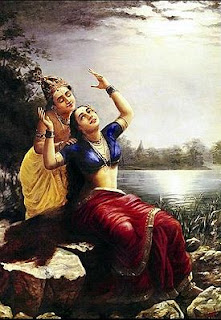In the story of Krishna, as told in the Mahabharata and the Bhagavata Purana, he spends much of his childhood in the company of young cow-herd girls, called Gopis in the village of Vrindavan. Krishna left his native place at the age of twelve for study at gurukul .The Mahabharata does not describe Krishna's earlier life in Vrindavan in much detail, and focuses more on the later battle of Kurukshetra but within the Bhagavata Purana the child-hood pastimes of Krishna are described very vividly. Within the Bhagavata Purana, Radha is not mentioned by name but is alluded to within the tenth chapter of the text as one of the gopis whom Krishna plays with during his upbringing as a young boy. Krishna left Vrindavan for Mathura at the age of 10 years and 7 months according to Bhagavata Purana. So Radha is assumed to be also 10 years old or less when Krishna left Vrindavan. It is in later texts such as the Gita Govinda where we find the story of Radha given in more detail.
Birth
Radha was the daughter of Vrishbhanu Gurjar who was king Suchandra in his previous life. Suchandra and his wife had acquired a boon from Brahmaji that in the Dwapar age Shri Laxmi will be born as a daughter to them in the form of Radha. King Suchendra and Queen Kalavati only were reborn as Vrishbhanu and Kirtikumari and Laxmiji was incarnated as Radha.
It is said that at Radha’s birth, Devarshi Narad himself went and met Vrishbhanu and informed him, “This girl’s beauty and nature is divine. All the houses, wherever her footprints are, Lord Narayan with all other deities will reside. Nurture this girl thinking her to be a Goddess.” According to Naradji’s advice, Vrishbhanu nurtured Radha with great love and care. Nandbaba who lived in the nearby village was friends with Vrishbanu. Once during the festival of Holi; Vrishbanu went to Gokul to meet Nandrai. At Nandrai and Yashoda’s house Krishna (who was growing up as their son) met Radha. Their union was divine, phenomenal and incessant. This meeting was Radha and Krishna’s first meeting which became eternal.
Radha’s love towards Krishna in the terrestrial or customary meaning is not just the relation between a man and woman. The feeling of this love is divine and phenomenal which gives this love a pious form. The philosophical side of this reduces the distance of the support and supportive, also the difference between the worshipper and worshipful is not there. Krishna is the life of Vraj; Radha is the soul of Krishna. That is why, it is said, “Atma Tu Radhika Tasya” (Radha, you are His soul). One form of Radha is, she is a devotee, worshipper of Krishna and in the second form she is the worshipful, devoted by Krishna. ‘Aradhyate Asau itii Radha.’ Radha – Krishna’s love is the symbol of the feeling of being united. When two souls are united, the difference of the other or the second vanishes.Her father Vrsabhanu was the king of cowherds Gop. Vrsabhanu was a partial incarnation of Lord Narayana while her mother Kalavati was a partial incarnation of Goddess Lakshmi.


